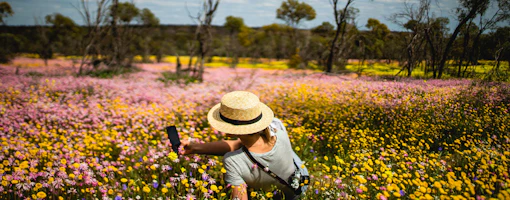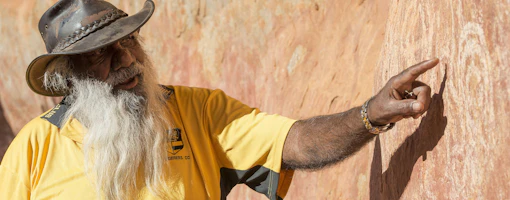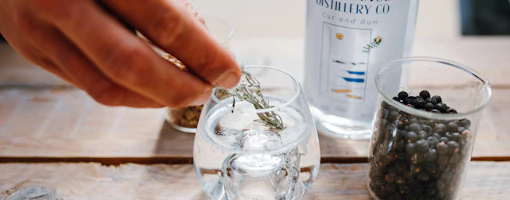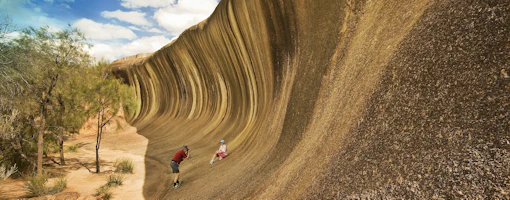
Where to see wildflowers
There is nowhere better to experience the world-famous Western Australian wildflowers than the Golden Outback - where orchids and everlastings carpet the landscapes in colour each spring.
Home to the biggest display of wildflowers in the world - both in size and in species - Western Australia puts on quite the show to celebrate the end of winter every year. In fact, with over 12,000 different varieties, the Golden Outback is the most diverse wildflower region on Earth, making it perfect for a springtime adventure!
During WA’S wildflower season - which runs from July to November every year - you can see wildflowers popping up all across the region, with pink, white purple and yellow everlastings as far as the eye can see in the Gascoyne-Murchison and the Goldfields, jewel-like orchids and the famous wreath flower in the Wheatbelt and the rather unusual-looking royal hakea in Fitzgerald River.
From hidden groves and reserves to billion-year-old granite rocks and national parks where the wildflowers outnumber the people by a million, read on to discover more about the best places to see wildflowers in Western Australia’s Golden Outback.
Top Tips for Wildflower Spotting
Wildflower season in WA can vary year on year, with some better than others. The best indication of whether it will be a bumper wildflower season is how much it rains over winter - the wetter the better, in this case!
Still, that doesn’t mean you won’t be able to see wildflowers on a bad year - they just might not be quite as epic, especially up in the Gascoyne-Murchison and the Goldfields. Luckily, the Wheatbelt and Esperance usually always manage to put on an impressive display, particularly on the orchid front.
Given how much we all love wildflowers in WA, there should be predictions made about the upcoming wildflower season that start in the winter, so keep an eye out for them. Another great way to find out how things are looking and when things have started flowering is to get in touch with the relevant Visitor Centre for the area you’re looking at too.
Where to see Wildflowers in the Gascoyne-Murchison

Wildflower season officially kicks off in the Gascoyne-Murchison around late July/early August and lasts several months, slowly following the sun south as the season progresses. Unfortunately, the drier regions are very much subject to the whim of the weather, so the wildflowers can be a little sparse after a dry winter.
Still, on a good year, the wildflowers in the Gascoyne-Murchison can be some of the best. It not only has the earliest flowers in the region, but it’s also usually quieter, meaning you can have all the flowers - and the stunning ancient landscapes - all but to yourself.
You can expect to find mulla mulla, scarlet red sturt desert pea, everlastings, native cornflower, eremophilia, flannel bush, cassias, acacias, bachelor buttons and golden billy buttons, to name just a few.
• Mount Augustus - the contrast between huge Mount Augustus (2.5x the size of Uluru) and the delicate wildflowers that grow here make this a total wildflower bucket list spot.
• Kennedy Range - between Mount Augustus & Carnavon, the waterfalls & gorges of Kennedy Range NP are some of the best places to see wildflowers on a bumper wildflower year.
• Gascoyne Junction - there are usually beautiful wildflowers to be found on the walking trails alongside the Gascoyne River. Bilung Pool is also worth a visit.
• Cue & Mount Magnet - keep your eyes out for carpets of everlastings around town.
• Paynes Find - the gateway to the Murchison, you can find everlastings and wattles brightening up the red roadsides around this old gold-mining hub.
• Yalgoo - a popular spot for seeing wreath flowers, there are also everlastings and orchids to be found around this historic town.
• Woolen Station, Nalbarra Station and Melangata Station – these vast stations are home to many wildflower species including everlastings and mulla mulla.
For more inspiration, check out the Road to the Rock road trip or read more about where to find the best wildflowers.
Where to see Wildflowers in the Wheatbelt
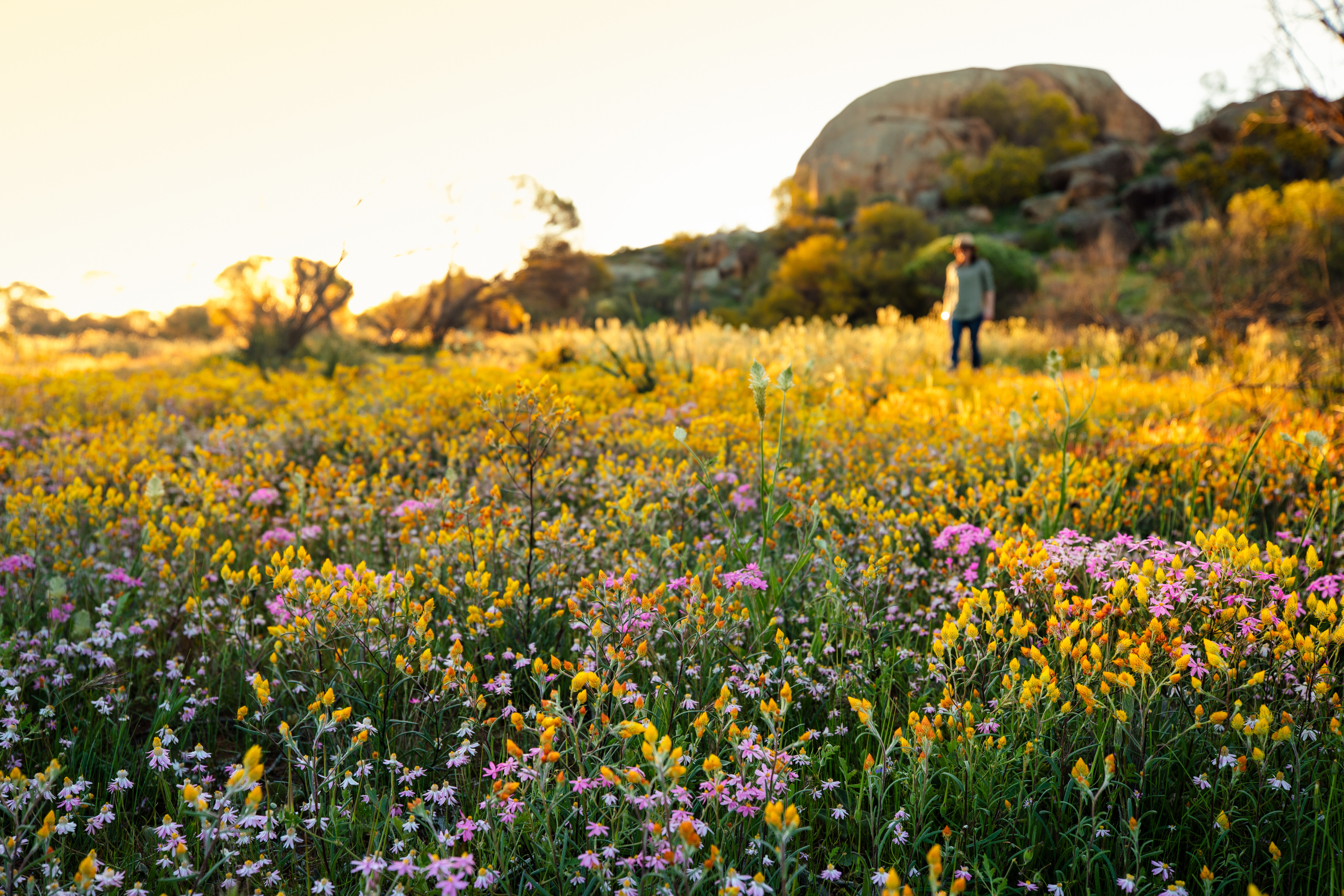
From August onwards, Western Australia’s wildflower wave starts to descend down into the northern Wheatbelt - and you’ll soon start to see dazzling arrays of wildflowers and fields of canola spreading across the landscape. Even on a dry year, the orchids tend to come out in abundance, but on a good year, the Wheatbelt has some of the best wildflower displays in the world.
One of the biggest regions in the state, the wildflowers of the Wheatbelt are as varied as the landscapes - from rolling hills and Monastic towns to farming hotspots, huge salt lakes and giant granite rocks dotted with colourful paper daisies.
In terms of flowers, you can expect to find everything from everlastings, pom poms, mulla mulla, wreath flowers, verticordia, banksia, sundew, mouse ears, fringed lilies, boronia, verticordia, scented custard powder grevillea, eromophilia, phebalium, macrocarpa, bottlebrush, thousands of varieties of orchid, and many more.
Download the 2023 Central Wheatbelt Wildflower Guide here.
The Northwestern Wheatbelt - Wildflower Country
The northeastern Wheatbelt is one of the best places to see wildflowers in Western Australia, with carpets of everlastings and wreath flowers attracting visitors from all over. Encompassing part of the Golden Outback, Wildflower Country also extends further west to the coast, including Mullewa, Coalseam Conservation Park, Mingenew and Coorow.
• Morawa - the bush around Morawa is filled with colourful blooms every spring, including native foxgloves. Koolanooka Springs, Bilya Rock & War Rock are also worth a visit.
• Perenjori - you can often find wreath flowers here along with amazing carpets of wildflowers, especially further out towards Camel Soak and Karara Rangeland Park (4WD).
• Wubin - around Wubin and Dalwallinu the wildflowers can be spectacular. Highlights include Petrudor, Jibberding, Xantippe Tank, Buntine Rock (4WD) and Mia Moon.
• Dalwallinu - famed for its wattle and its wildflowers, the Gateway to Wildflower Country is a great place for flower-spotting. Home of the Wattle Week Festival every September.
• Wongan Hills - there are over 1,200 varieties of wildflowers in Wongan Hills. Gathercole Reserve and Reynoldson’s Reserve are especially iconic - the latter hosting the Reynoldson Reserve Festival Weekend at the end of the season.
Take a peek at the three-day Wildflower Way and Everlastings Wildflower Trail self-drive road trip itineraries for more inspiration.
The Northeast Wheatbelt - along the Wheatbelt Way/Pioneers Pathway
Northeast of Perth, the Wheatbelt Way and Pioneers Pathway are amazing road trip trails that encompass heritage towns, pioneer history and amazing views over the bush, with rolling hills, salt lakes and huge granite rocks that spring into colour after a nice wet winter.
• Beacon – Billiburning Rock is home to many spectacular wildflowers right on the edge of the Wheatbelt with views across to Karoun Hill Nature Reserve (and it is also a great spot for birdwatching). Make sure you plan your trip for the Monday Beacon Guided Wildflower Tour.
• Bencubbin – Marshall Rock is a wonderful spot to enjoy 360 degree views of the surrounding farming landscape and at the base of the rock you will be treated to wonderful displays of white and yellow everlastings as well as Spider Orchids and much more.
• Dowerin - Tin Dog Creek Reserve has many flowers in season, while Namelcatchem Reserve and Minnivale are also well worth a visit.
• Koorda - famed for its verticordia and Koorda Rose, Koorda Native Flora Reserve and Mollerin Reserve are beautiful, as is Newcarlbeon Rocks, where you can camp out under the stars.
• Wyalkatchem - the Wyalkatchem Reserve, Korrelocking Reserve and the golf course are usually full of flora and fauna every springtime, including fields of everlastings.
• Trayning - Billycatting Reserve is home to insect-eating plants, while the gnamma holes north on Bencubbin Road have lots of orchids.
• Nungarin - Check out the wildflowers at Eaglestone Rock, Talgomine Reserve & Danberrin Hill, where you can see (and smell) the native vanilla bush. Mangowine Homestead is also amazing, so swing by if you get the chance.
• Westonia - Elachbutting Rock and the Woodlands & Wildflowers Heritage Walk in the Westonia townsite are highlights, with plenty of orchids and everlastings. Sandford Rocks and Boodalin Soak also have lots of orchids.
• Mukinbudin, between Mukinbudin and Bonnie Rock, there are heaps of amazing wildflowers, especially around Beringbooding Rock - 72kms north - where you can find eromophilia, pink tea tree and many more.
For more info on wildflowers in the northeastern Wheatbelt, take a look at our Granite Wildflowers and Granite Loop Wildflower Trail self-drive road trip itineraries.
The Central & Eastern Wheatbelt - along the Golden Pipeline Heritage Trail
During spring, you can see wildflowers all along the side of the road and in the reserves as you traverse the Great Eastern Highway. Roughly following the Golden Pipeline with its precious water cargo between Mundaring and Kalgoorlie, you’ll find heaps of native wildflower hotspots, but these are just a handful of our favourites.
• Cunderdin - Cunderdin Hill and Bulgin Rock Reserve are great spots for everlastings.
• Tammin - Check out the Charles Gardner Reserve and Yorkrakine Rock, a solid granite outcrop surrounded by native wildflowers.
• Merredin - Merredin Peak has a rich Aboriginal history as well as plenty of beautiful wildflowers, including sundews and green-veiled shell orchids.
• Kellerberrin - Kellerberrin Hill is a beautiful wildflower spot offering amazing views over town, while nearby Durokoppin Reserve is home to heaps of colourful flowers.
• Southern Cross - follow the Yilgarn Wildflower Drive and check out all the wildflower reserves off the Great Eastern Highway between Southern Cross and Coolgardie, including Yellowdine Nature Reserve, Karalee Rock, Boorabin National Park and Boondi Rock.
Feeling inspired? Check out our Goldfields road trips: the Granite & Goldfields Wildflower and Goldfields Wildflower Trail to find out more.
The Eastern Wheatbelt - along the Pathways to Wave Rock
While it isn’t really surprising how different parts of the Wheatbelt can be from others given the sheer size of it, it can still feel like you’re visiting a totally different region, where the climate and landscapes are different - and the wildflowers are too. Here are some of the best places to see wildflowers in the eastern Wheatbelt.
• Bruce Rock - check out the Jura Wildflower Drive along with Bruce Rock Reserve. Nearby Kwolyin and Kokerbin Rock are also colourful wildflower hotspots.
• Narembeen - see boronia, verticordia and drosera in nearby reserves, like Hidden Hollow, Twine Reserve and Anderson Rock Reserves.
• Corrigin - starting opposite the Dog Cemetery, Corrigin Wildflower Drive has loads of great wildflowers to offer, as does the Corrigin Wildflower Reserve, where you can see (and smell) custard powder grevillea, green-veined shell orchids and phebalium.
• Kondinin - go orchid spotting at Yeerakine Rock and check out acacias and phebalium at Bendering and North Kalgarin Reserves.
• Hyden & Wave Rock - while Wave Rock steals the show, the wildflowers are pretty great too, with wattle, scarlet bottlebrush, grevillea and orchids blooming all around it.
• Kulin - the macrocarpa walk is pretty spectacular when they’re in full bloom, as is North Jitarning Nature Reserve, while Hopkins Nature Reserve is a prized floral conservation area.
• Lake Grace - known for it’s Orchids and diverse range of unique wildflowers. The Jam Patch nature reserve and Kwongan Heathland walk are popular hotspots.
Discover even more about the wildflowers in the eastern Wheatbelt on the Wave Rock Wildflower or Coastal Wildflower Trail road trips.
Southern Wheatbelt
Southeast of Perth, the Southern Wheatbelt is another prime place to see wildflowers in Western Australia, with places like Dryandra Woodland and Williams Reserve just about close enough to make a wildflower day trip from Perth.
• Dryandra Woodland - home to plenty of native flora and fauna, including an abundance of wildflowers during spring, you can also stay overnight and take a nocturnal wildlife tour.
• Narrogin - there are heaps of great places to go wildflower spotting around Narrogin, including Foxes Lair Nature Reserve, Yilliminning Rock and Highbury Nature Reserve, where you can see everlastings, orchids and kwongan flowers.
• Williams - Just off Albany Highway, Williams Nature Reserve is another great spot to see an array of colourful wildflowers - and a nice easy stopover on the way down south.
For more inspiration, check out the Wheatbelt & Winery Trail or the 7-10 day Esperance Wildflower Trail.
Where to see Wildflowers in the Goldfields
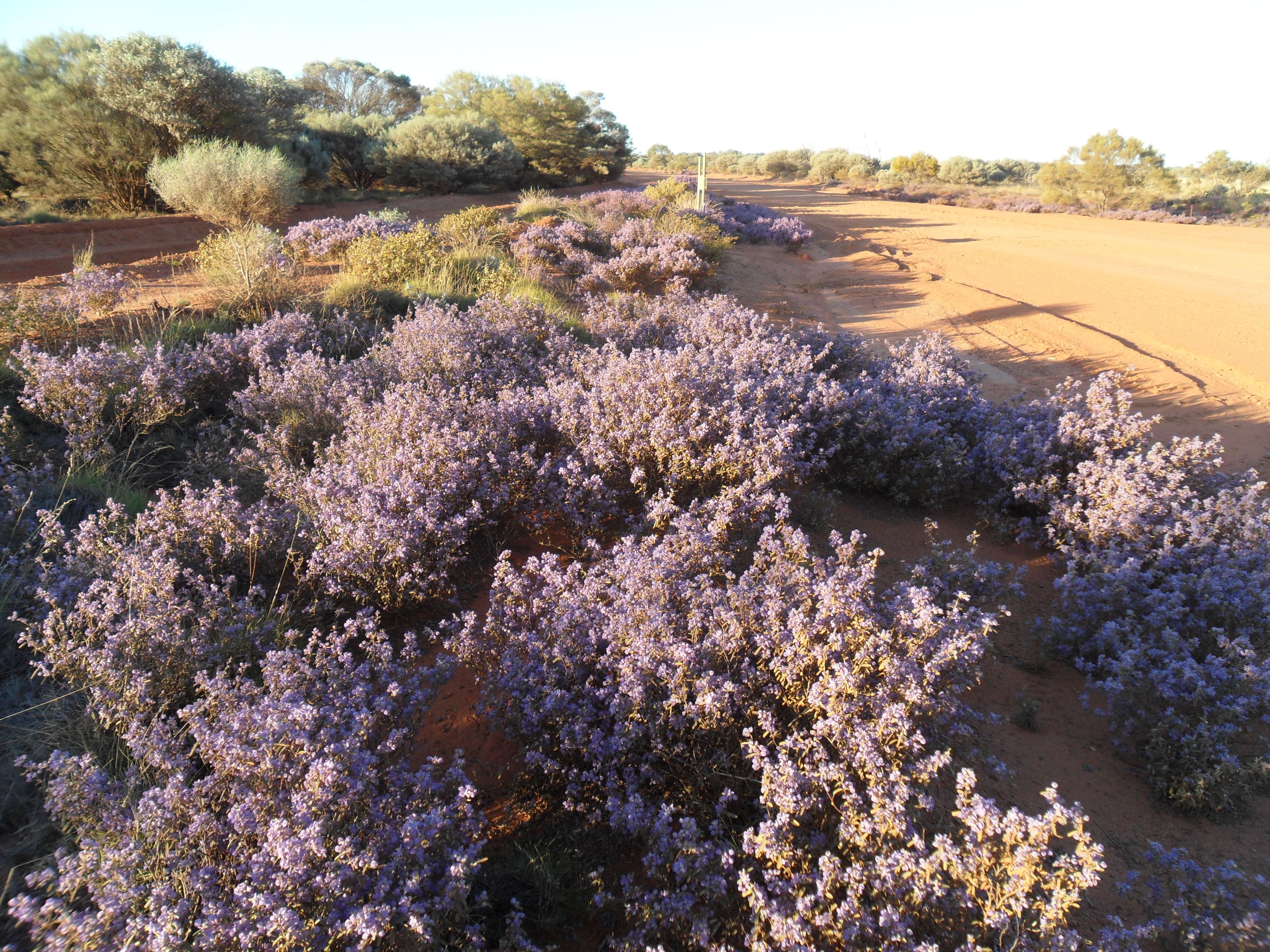
While you can usually start to see the first signs of wildflowers in the Goldfields from August onwards, wildflowers out here can be a little bit of a mixed bag. In a good year, they can be absolutely spectacular, while in a not-so-great one they can be a little shy and don’t quite put on the epic displays they do after very wet winters.
Fortunately, the Goldfields wildflower hotspots also line up with the best attractions in the Goldfields - from the epic statues at Lake Ballard to the spooky gold-rush ghost towns and the rich architecture and heritage of Kalgoorlie, along with the fascinating story of the Golden Pipeline and the starry night skies. And, with perfect temps, spring is the ideal time to visit anyway, so the wildflowers are just the cherry on the cake.
Wildflower-wise, you can expect to see mulla mullas, bush tomatoes, eremophilas, sundews, everlastings, sturt peas and a whole plethora of orchids, amongst many more.
• Coolgardie - there are plenty of wildflower hotspots along the Great Eastern Highway into Coolgardie, like Yellowdine Nature Reserve, Karalee Rock, Boorabin National Park and Boondi Rock. Around Coolgardie itself, you can usually find eremophilas, native hop bushes, mulla mullas and bush tomatoes.
• Kalgoorlie-Boulder - one of the best places to see wildflowers in the Goldfields is Karlkurla Park, where you’ll find plenty of wildflowers endemic to the region, including eremophilas, jam wattle, tan wattle, Kalgoorlie hop bush, thorny hovea, lemon-flowered gum, Goldfields daisy, cassia and westringia rigida.
• Menzies & Lake Ballard - not only is Lake Ballard one of our favourite places in the Golden Outback, it’s also a great spot to see bush flowers, wattles, native cornflowers, everlastings and eremophilas. You can also see them around Goongarrie and Niagara Dam. Menzies Cemetery also usually has lots of flowers blooming around it and you can sometimes see sturt peas on the road up to Menzies from Kal.
• Leonora & Gwalia - the Leonora Loop Trails are a good place to start when wildflower-searching in the Goldfields. You can usually see everlastings, smoke bush and billybuttons, along with purple flannel bush.
Want to know more? Take a look at the Granite & Goldfields and Goldfields Wildflower Trail road trip itineraries.
Where to see Wildflowers in Esperance, Fitzgerald Coast, Norseman & the Nullabor
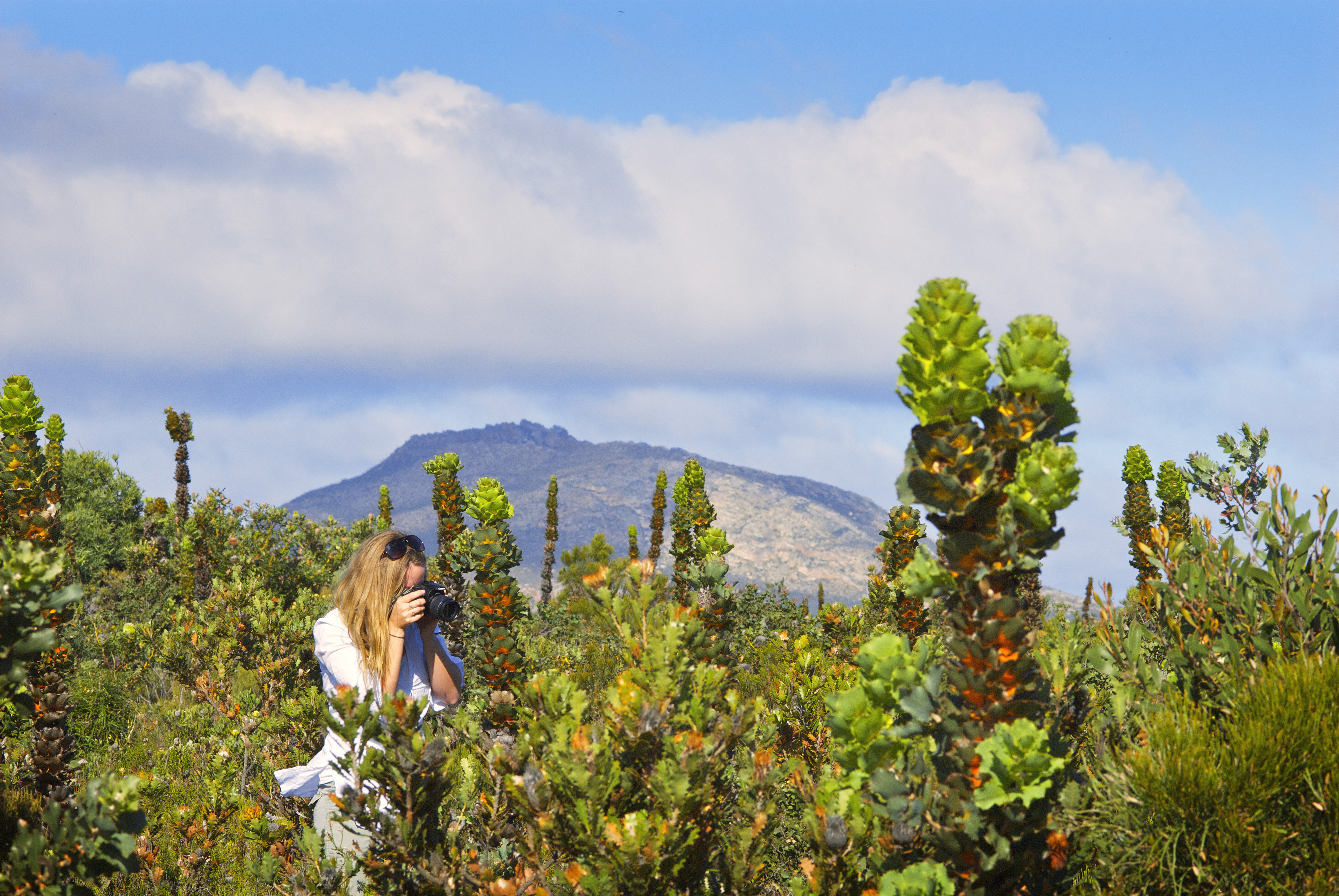
By the end of August/early September, Western Australia’s wildflower wave has usually started to make its way south to the coast, where the National Parks are transformed with vibrant colourful blooms, perfectly contrasted against the colours of the ocean. This is also prime whale-watching season in Esperance - just in case you needed another excuse to visit this beautiful part of the world.
There are also two festivals every September that celebrate and showcase wildflower season down here: the Esperance Wildflower Festival and the Ravensthorpe Wildflower Show and Spring Festival, so be sure to check them out if you’re in town.
Flower-wise, the region is home to many different varieties of wildflowers, including the royal hakea, cauliflower hakea, taxandria marginata, pink-flowered silver tea tree, leptospermum sericeum, redcaps, dainty wedding brush, ricinocarpos pilifera, banksia and even the carnivorous utricularia menziesii, along with the beautiful qualup bells, acacia, wattles and orchids.
• Esperance - check out the wildflowers at the Helms Arboretum, the Dempster Head Walk Trail, Woody Lake Nature Reserve, Lake Moningup and the Great Ocean Drive. Esperance Wildflower Festival is also amazing, with over 500 different local species.
• Cape Le Grand National Park - while Cape Le Grand might be best known for Lucky Bay and its kangaroos, the park is especially stunning in spring, with flowers everywhere you look. Climb Frenchman Peak for epic views.
• Ravensthorpe - home of the Ravensthorpe Wildflower Show & Spring Festival and the beautiful qualup bell flower, along with some larger than life year-round banksia blooms on the Ravensthorpe PUBLIC Silo Trail.
• Fitzgerald Coast - the Fitzgerald River National Park is one of the best places in WA to see wildflowers, where the rugged rocky coastline and ancient mountain ranges play host to over 1,800 different varieties of colourful wildflowers every spring.
Raring to hit the road? Check out our five-day Coastal Wildflower and 7-10 day Esperance Wildflower Trail road trips for more wildflower trip planning inspiration.

Wildflower hotspots
Throughout the upcoming season, we will collate the best information that we have, bringing you insight from all across…
Read more about Wildflower hotspots
Wildflower Shows
Western Australia’s Golden Outback is in bloom and it’s never been easier for visitors to see the rare and natural phenomenon with tours on offer and three wildflower shows confirmed. Find out more here.





